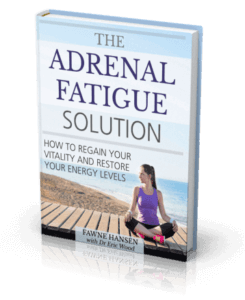Diagnosing Adrenal Fatigue from a single test or symptom is very difficult. To make an accurate diagnosis, doctors and naturopaths need to look at a range of tests, sometimes conducted multiple times, and take note of every symptom. This requires experience and a thorough knowledge of the various systems in your body, as well as some patience too. It may require two or three visits to the doctor before you can be sure that you have Adrenal Fatigue.
Testing for Adrenal Fatigue can take several forms. First we have the standard hormone tests, which include testing for cortisol and various thyroid hormones. These are the tests that your medical doctor will likely give you. Then we have the tests more frequently used by integrative doctors or naturopaths – these tend to look at the ratios of various hormones and neurotransmitters, in order to get a better idea of how a patient is feeling. And lastly we have a set of more subjective physical tests, which were mostly developed in the early days of Adrenal Fatigue diagnosis.
To diagnose Adrenal Fatigue correctly requires using a combination of lab testing and feedback from the patient (questionnaires can also play a useful role). On this page I will give a brief summary of the major tests that can be used in an Adrenal Fatigue diagnosis. Dr Wood and I discuss these tests in more detail in The Adrenal Fatigue Solution, along with some revealing tests used by integrative doctors.
Cortisol Tests
The major lab test used to diagnose Adrenal Fatigue is, as you might have guessed, the cortisol test. But there is more than one type of cortisol testing, and the correct interpretation of results is also important.
Depending on his or her preference, your doctor may order a saliva, blood or urine test to measure your cortisol. These days it is generally accepted that saliva cortisol testing is the most accurate, as it gives a better estimate of the cortisol levels within your cells, where the hormone reactions are actually taking place. Remember that it is important to be well-hydrated before you do your saliva test – dehydration can skew the results.
Here’s another important thing to know about cortisol testing. Taking a single measurement, or even a 24-hour average, is not enough. The best cortisol tests take 4 individual samples at various points of the day and then map your cortisol levels over the course of a 24 hour cycle. Our cortisol levels vary dramatically, starting high when we wake up and then tapering off until they reach their lowest point late at night. This usually represents something like an 80% drop, which is perfectly normal. Your health care professional needs to see not just your average cortisol level, but also the size of the morning spike and how sharply it drops off afterwards.
Interpreting the results correctly can be difficult for a physician without experience of Adrenal Fatigue. The reference ranges supplied by labs are so wide that they only flag up extremely low cortisol levels. So your doctor will need to look at the levels provided and make his or her own judgment. This is where the importance of using an optimal range, rather than the reference range, becomes clear.
Lastly, your health care professional should be aware that more than one cortisol test will be necessary during your treatment for Adrenal Fatigue. Once you have been diagnosed and started on a treatment course, saliva cortisol testing is a good way to monitor progress as your cortisol levels begin to return to normal.
ACTH Challenge
This is another kind of cortisol test that can be very useful for your doctor. First, your baseline cortisol levels are measured. Then, a dose of ACTH (adrenal corticotrophic hormone) is injected. Finally, your cortisol levels are measured again.
The ACTH has the effect of stimulating your adrenal hormone output, just like it would if you were placed in a stressful situation. This test allows you to see the response of your adrenals to stress. If your cortisol exhibits a healthy spike higher (at least double in a blood test), your adrenals are probably in reasonably good shape. If the spike in cortisol is not so large, this suggests adrenal insufficiency.
Thyroid Tests
You might wonder what the point of a thyroid test is, when we are looking to diagnose Adrenal Fatigue? The complexity of the human body means that one part of the endocrine system (the HPA axis) cannot exist independently of another part (the thyroid). In reality, there are connections and relationships that exist between every system in the body, and a weakness in one area can easily translate into changes in another.
In the case of Adrenal Fatigue, it has been shown that a weakening in the hypothalamus and pituitary gland (the other parts of the HPA axis) can lead to lower thyroid function. In other words, if your blood tests suggest mild hypothyroidism, the underlying problem might actually be Adrenal Fatigue.
There are a number of different tests for thyroid function, all blood tests. Here I’m going to give a brief summary of the most important ones. As with the cortisol test, your doctor should be looking beyond the reference ranges provided by the lab. In fact, these days it’s very common for someone to be diagnosed with mild hypothyroidism even if all their results are within the range.
TSH
Thyroid stimulating hormone is produced by the pituitary gland in response to instructions from the hypothalamus. As its name suggests, TSH stimulates the thyroid to produce T3 and T4, the two most important thyroid hormones.
The level of TSH is inversely proportional to the activity of your thyroid. If your thyroid is producing lots of T3 and T4, your pituitary gland produces less TSH (because the thyroid needs to be stimulated less). Conversely, if you are hypothyroid then your TSH is likely to be high, as your brain is telling the thyroid to produce more hormones. This is the same kind of feedback loop that exists for many other hormones in the body, including cortisol.
In the case of Adrenal Fatigue sufferers their thyroid is often performing weakly, so they will typically have a TSH reading of above 2.0. Note that the reference range provided by the lab will usually be around 0.50 – 4.50. Once again you can see the importance of looking for an optimal level rather than just blindly following the lab ranges.
Free T3 (FT3)
This is a test that is rarely conducted by doctors, and even then usually only on hyperthyroid patients. However it can give a useful insight into the overall function of the thyroid. T3 is produced when TSH stimulates the thyroid. When used in conjunction with the other thyroid tests, this helps to give a complete picture of why the thyroid is underperforming. Optimal values should be somewhere in the 300-450 pg/ml range. However, the typical lab range allows values as low as 230 pg/ml.
Free T4 (FT4)
Similarly to T3, this hormone is produced when TSH stimulates the thyroid. Your thyroid makes much more T4 than T3, but T4 tends to have less of an effect on the body than T3 does. If your thyroid is producing too little T4, often your TSH level will be higher. This test measures Free T4, which is ‘unbound’ and available for immediate use.
Total Thyroxine (TT4)
This test should be used along with the Free T4 test. While Free T4 measures the amount of unbound and available T4 in your blood, Total Thyroxine also includes the amount of T4 that is bound to carrier proteins (essentially held ‘in reserve’). Using this test together with the Free T4 test will tell you how much T4 is available for your body to use, and how much is being held in reserve.
Tests used by integrative doctors
In addition to the tests listed above, there is a selection of tests that provide more of an insight into the relative levels of different hormones or neurotransmitters in your body. These will rarely be ordered by a medical doctor, but your integrative doctor or naturopath may ask for them.
Cortisol / DHEA Ratio
This test tells us which point along the Adrenal Fatigue pathway the patient might have reached. In the initial stages of a stress reaction both cortisol and DHEA will be high. But as the body begins to struggle to produce sufficient stress hormones, DHEA levels start to fall. Put very simply, this is because the stress hormone production ‘steals’ resources from the sex hormone production. Further on in the development of Adrenal Fatigue, cortisol levels will begin to drop too. So this ratio, combined with other tests and information, helps us to determine which stage of Adrenal Fatigue the patient has reached.
17-HP / Cortisol Ratio
17-hydroxyprogesterone (17-HP) is a precursor to cortisol, in other words one of the ‘raw materials’ that the body uses to create cortisol. In Adrenal Fatigue sufferers it is common to see higher levels of 17-HP vs. cortisol, as the adrenals struggle to make this conversion happen.
Neurotransmitter Testing
I’ve spoken exclusively about hormones so far, but neurotransmitters are another important part of our endocrine system. These chemical messengers transmit messages between our cells and, just like cortisol, they can become depleted after long periods of stress. With recent developments in testing procedures it is now possible to compare a patient’s neurotransmitter levels to a reference range for healthy patients. This test is usually conducted first thing in the morning and is best accomplished via a urine test. It is only available from a small number of labs.
Alternative Tests
When Adrenal Fatigue was first diagnosed many of these tests did not even exist. To help provide a diagnosis, doctors developed a series of more physical tests that can be conducted quickly in a doctor’s clinic or at home. These tests are clearly much less accurate than the blood, saliva and urine tests mentioned above, and positive results may reflect other health problems besides Adrenal Fatigue. However they can be a useful diagnostic tool in combination with all the other evidence provided.
The Iris Contraction Test
First described by Dr. Arroyo in 1924, this test measures the contraction of the iris in response to repeated exposure to dark light. In those with weakened adrenal function, the theory goes that the iris will be unable to maintain its contraction for long.
To conduct the test, sit in a darkened room, in front of a mirror. Take a flashlight and shine it across your eye, from the side of your face. In a hypoadrenal state, your pupil will not be able to hold onto its contraction for more than 2 minutes and thus will begin to dilate despite light repeatedly shining on it. In those with healthy adrenals, the contraction should last much longer.
Postural Low Blood Pressure
When we stand up, those of us who are in good health experience an almost immediate rise in blood pressure. In contrast, Adrenal Fatigue sufferers will see no change in their blood pressure, or even a slight fall. In very general terms, a larger drop in blood pressure signifies a more severe case of Adrenal Fatigue.
This is a very simple test to do at home. Use your regular blood pressure monitor and check your blood pressure while lying down. Then stand up and conduct the test again.
Do you have Adrenal Fatigue? A few changes in your diet and lifestyle can go a long way to getting your energy levels back. You can also use some natural supplements to give your body the support it needs to recover. Dr Eric Wood and I teamed up to write The Adrenal Fatigue Solution, which contains a comprehensive plan to recover from Adrenal Fatigue.



